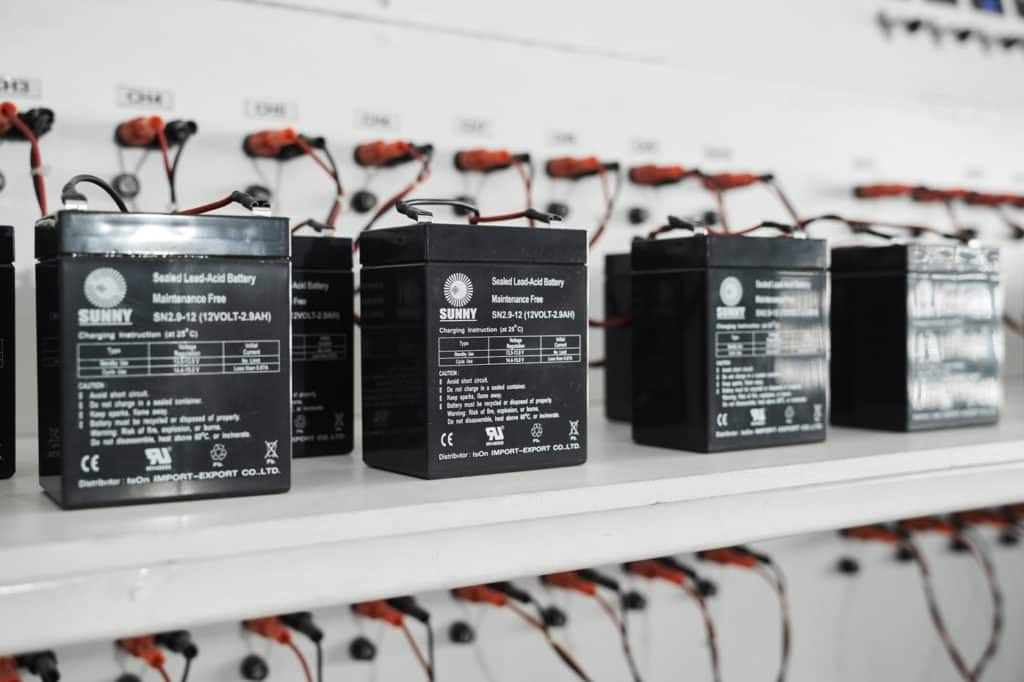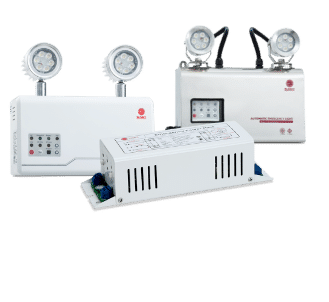FAQ
About
PRODUCT

Answer : The Transfer Relay installed in the inverter will relay power from the control box to the lamps but the Transfer Relay bought separately will relay the current from the desired external source into the control box.
Answer : The recommended temperatures are between 0-40 degree Celsius.
Answer :
- Plug in the unit.
- Perform a test every 30 days.
- Take the unit to a service center after 2 years prior to replacing the battery.
Answer : The Auto Test will simulate a power outage by cutting the power supply to the unit and letting the battery power the emergency lamps. After 1 hour the circuit will reconnect the power supply to the unit and the charging circuit will charge the battery back to full capacity. After the test is perform the internal timer will then be reset.
Answer : The main checkups are
- Check to see at what Voltage the charging circuit will stop charging the battery.
- Check to see if the battery can still supply power under heavy load.
- Check to see if the Low Voltage cut-off circuit is still operating correctly and at what Voltage does it cut-off.
- Check to see if the circuit that delays turning off the emergency lamps for 5-8 seconds after power is restored is still working correctly.
- Check to see if the power outage detector is still working properly. The emergency lamps should turn on within 2 seconds after a power outage occur.
These are all the main components of the emergency lighting unit that should be inspected. Other miscellaneous components can also be checked depending on the model and functionalities but the ones listed here are the core and most important functions, therefore these are the main checks that are always performed.
Answer :
- The TISI 1102-2538 certificate ensures a good standard for emergency light units.
- The TISI 1955-2551 certificate is an enforced standard on the quality of lighting and similar products such as lamps, exit signs and control boxes to ensure that it does not emit excessive radio interference.
- CE Mark is a European standard for lamps, exit signs and batteries.
- Rohs Mark ensures that certain harmful chemicals are not used in electrical appliances, lamps, exit signs, batteries and other products. This standard means that the amount of contamination from compounds such as Lead in the products are less than 0.1% of the total product mass. The standard tests for 6 total compounds such as Lead, Mercury, Cadmium, Hexavalent, Polybrominated Biphenyls Ethers and Polybrominated Biphenyls.
- The CE and UL certifications are European and American standards for batteries. SUNNY’s batteries have received both CE and UL certifications.
Answer : About 80 centimeters.
Answer :
- Is the unit plugged into a 220VAC power supply?
- Is the unit receiving power? (this can check from the indicator)
- During standby, if the Test switch is activated does the lamp turn on?
- Is the power switch on the unit set to off? (on models with a power switch)
- Check to see if a battery has been installed in the unit.
- Has the unit been left to charge for 10-15 hours?
- Are the lamps, lamp sockets and fuse in good working condition?
Answer : About 10-15 hours.
Answer : For the NAU, SAU and SN models.
- Open the cover of the unit.
- Look for the battery terminals.
- If the battery terminals are loose, reinsert it into the circuit board.
- Test the unit to see if the issue is resolved.
- Close the cover and screw back in the screws.
About
BATTERY

Answer : Usually this is caused by how the batteries are charged.
What kind of charging will cause the battery to swell or shatter?
- When quick charging a current 30% higher than the battery’s capacity is used. Using a high current like this will cause a lot of heat and the battery casing that is made from plastic can become soft. A lot a gaseous vapor will also build up inside causing a high-pressure buildup inside the battery case. This can make the case swell and with prolonged charging the pressure can shatter the battery.
- Incorrect charging methods can also cause issues. A safe method for charging is to use normal charging, using a current not more than 10% above the battery’s capacity. Even with normal charging, however, if the capacity limit of the battery is incorrectly set problems can arise. With this even when the battery is full a current will still be fed to the battery. If this continues for a long period of time the battery can become hot and swell even though the current does not exceed the normal charging current.
Answer : With all current batteries no matter the type or the brand this is an issue, how much of an issue depends on
- The type of battery.
- The temperature and humidity where the battery is being stored.
The issue is Self-Discharged. Even though the battery will self-discharge at such a slow rate but over a long period of time without recharging the charge level can fall so low that the electrolyte inside the battery, which is acidic (or in some cases and alkaline), will lose its acidity. This will cause the surface of the elemental plate inside the battery to oxidize, reducing the surface area where it could react with the electrolyte. If the entire surface of the elemental plate oxidizes then it will no longer be able to charge.
With this issue it is impossible for the user to definitely know how often the battery should be recharged to prevent the problem. Still, if left for too long without recharging then the battery can begin to deteriorate.
How should this issue be solved?
There should be an audible warning when the battery’s capacity falls below a certain level so the user will know when to recharge the battery.
How is this audible warning implemented?
The audible warning is triggered by a Battery Checker circuit. The circuit will constantly check the OCV (Open Circuit Voltages), checking for the Voltage at the battery terminals. When the capacity falls the Voltage at the terminals will also fall. The circuit is set so that when the battery’s capacity falls to about 70% (as specified in the battery manual) a high-pitch audible warning will be triggered every 15 seconds until the battery is recharged.
Answer : Some might say that they are different types of battery, which is true, but that is not the main reason.
Then what is the real reason?
The real reason is the use case. Mobile phone batteries are put under Circle Use while batteries in emergency lighting units are in Standby Use.
What is Circle Use?
Circle use is recharging the battery when it runs low, then when it is full it is used again.
What is Standby Use?
Standby Use is when the battery is kept fully charged with a current being continuously fed to it. This is so when there is a power outage the battery is always ready to be used. This constant current being fed to the battery is the main cause for its faster deterioration.
If we use the emergency lighting unit every day similar to the mobile phones then its battery life will be similar. In reality this probably would not be possible or practical.
Then how should we solve this issue?
With a new innovation to charge Standby Use batteries in a way similar to Circle Use batteries. This charging circuit is called a 3 Step Charger and it is designed to solve this problem.
What is a 3 Step Charge and how does it work?
A 3 Step Charger is a battery charging circuit that will cut the charging off when the battery is full, similar to Circle Use batteries so there is not a constant current being fed to the battery.
The 3 Step Charger works by
Step 1. If the battery level is extremely low, the circuit will limit current charging the battery to no more than 10% above its capacity.
Step 2. When the battery level becomes higher the charging current will be reduced and the charging circuit will switch the charging method to a Constant Voltage Charge.
Step 3. Once the battery is full the circuit will change to Flip Flop Charging. Current will be cut off and the battery left to discharge until it reaches a predetermined OCV level (specified in the battery’s manual). Once this happens the battery will be put under Constant Voltage Charge until it is full again.
Answer : Every electrical equipment will have a finite operating life; an emergency lighting unit is no different. Even though it may seem that the unit is not being used under normal circumstances, but with the battery always self-discharging the automatic charging system will always have to top the battery up and therefore it is in effect under constant use. With this in mind it is impossible for the battery to have the same performance as when it was initially installed. The amount of deterioration will depend on the circuit design.
With our 2-year warranty we guarantee that the battery will be in good operating order, but might not be at the exact same performance level.
Answer : As mentioned previously the batteries in emergency lighting units are put under Standby Use. This means that there will be a current to recharge the battery compensating for the battery’s self-discharge. With this constantly happening when there are no power outages the battery will deteriorate rather quickly. With this it was felt that if there are no power outages for a long period of time the battery should be allowed to discharge to get some use out of the elemental plates.
How long without a power outage before the battery should be allowed to discharge?
Optimally it should probably be every day, but in real practical use that is probably not practical. Therefore, we feel that a 30-minute discharge every 30 days is probably a good target.
Initially we would advise the user to unplug the unit for 30 minutes every 30 days before replunging. This was not very convenient however.
That is why we have designed the Auto Test circuit. The circuit will cut the power supply for 30 minutes every 30 days, simulating a power outage. With further development options for the regularity and power cut durations were implemented.
Can the Auto Test circuit really extend battery life?
From our collected data the Auto Test circuit will increase the battery life, but only to an extent. Even with the Auto Test circuit the battery will experience performance deterioration, because the circuit is attempting to solve the problem at end point (output) and not at the root cause. The source of the problem is at the input (If there is a problem at the input then there will be no output).
Then how to solve the problem at the input?
As mentioned previously it should be resolved by the method used to charge the battery.
Answer : When the emergency lighting unit first came onto the market it only had very basic functions. When the power went out the lights will turn on. It did not have any complicated functionalities like it has today. The most it might have is a switch on the unit to initiate a test (Manual Test), so that the user does not have to unplug the unit in order to test it. With the units often installed in high places this can be very inconvenient. In the early days the units used incandescent lamps, which were very inefficient and blew out very often, performing regular tests was therefore very important.
With this in mind the Remote Testing circuit was designed to solve the problem. Now the units can be tested remotely from afar.
The remote test is to check if the unit is operationally ready and the auto test is to discharge the battery regularly when there have not been any power outages.
With the increasing competition in the emergency lighting market manufactures have increased the functionality of the Remote Testing circuit to a point where some functionalities now overlap with that of the Auto Test. It is all a positive, however, for the end user since they can now operate the units in a variety of ways.
Answer : Batteries stored electrical energy in chemical form. Different chemicals are used depending on the elemental plate and electrolyte, giving different types of battery advantages and disadvantages. One thing they all have in common is that they cannot be operated until fully discharged otherwise they will severely deteriorate in performance. The level of deterioration depends on how much charged is left in the battery. If the battery is completely drained and not recharged immediately then the battery could be permanently damaged.
This could be a problem because we do not know how long each power outages will last. For short period of time, it should not be a problem but if the power outage last too long the battery could be completely drained and be permanently damaged.
To solve this problem each battery manufacturer will specify a minimum level of charge for which the battery should not fall below. This is extremely important in the operation of the battery, not only for emergency lighting units but for all electrical appliances. A circuit to switch off the battery is therefore necessary to prevent the battery from falling below its safe level of charge. This circuit is called the Low Voltage Cut Off or Low Voltage Disconnect.
Answer : The importance of the Low Voltage Cut Off circuit was mentioned previously, to cut off the load on the battery once the charge level falls below its minimum safe level. When the power outage lasts for too long and this happens the Low Voltage Cut Off circuit will turn off the lamp of the emergency lighting unit. Modern emergency lighting units use LEDs with a Driver circuit that will keep the LED’s brightness constant even with falling charge in the battery. This means that the user will not be able to tell at all when the battery is starting to run low.
This can be a problem as the user might not have a chance to prepare an alternative source of illumination before the emergency lighting unit turn off.
For this there is a Low Voltage Sound Indicator circuit. The circuit will trigger an audible warning every 15 seconds until the Low Voltage Cut Off activates and switches off the unit.




